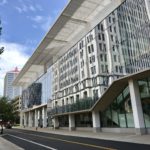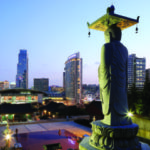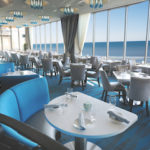It’s made up of 63 small islands — the largest of which, Singapore Island, measures only about 275 square miles and is heavily urbanized and development-focused. But what struck me during an exclusive visit hosted by the Singapore Tourism Board in January was the amount of greenery that surrounds, inhabits, and grows through nearly every space. You feel as though you’re enveloped in a lush and rich landscape in the midst of the bustling metropolis, which has become a major meetings destination in Southeast Asia.
Almost nowhere was this greening more evident than on my visit to the brand-new PARKROYAL on Pickering, which had opened just the week before, on Jan. 16. Designed as a “hotel-in-a-garden,” the stunning 367-room PARKROYAL features gardens, waterfalls, and living walls that equal more than twice the property’s total land area. The property also has solar-energy-powered sky gardens and uses rain harvesting to keep its facilities hydrated, and its meeting and event spaces offer flexible configurations for up to 800 people, including a ballroom and six conference and meeting rooms.
The Fullerton Hotel is located near the mouth of the Singapore River, in a historic building that once served as the General Post Office and the Chamber of Commerce. Combining luxury and history, the five-star, 400-room property offers three ballrooms that can accommodate up to 600 people theater-style, and seven meeting rooms. Its smaller sister property, the Fullerton Bay Hotel, is located across the street, overlooking Marina Bay, and features custom-built floating pods that function as unique meeting and reception spaces.
The magnificent Marina Bay Sands is a standalone casino property built along Marina Bay that encompasses a resort with a 2,561-room hotel, a 1.3-million-square-foot convention and exhibition center, The Shoppes at Marina Bay Sands mall (including a museum, two theaters, seven celebrity-chef restaurants, and high-end retail), and the world’s largest atrium casino.
Another integrated resort property, Resorts World Sentosa, is located on the island of Sentosa, just off the southern coast of Singapore Island. The property includes Singapore’s second casino, a Universal Studios theme park, and Marine Life Park, which features the world’s largest oceanarium. The resort is home to six hotels totaling 1,800 rooms, including the 360-room Hard Rock Hotel Singapore, which houses the region’s largest column-free ballroom, with seating for 6,500 guests, and an additional 30 function rooms in the Resorts World Convention Centre.
I didn’t get the chance to tour Suntec Singapore International Convention and Exhibition Centre because it’s under construction and slated to reopen in May. The $146-million renovation will reconfigure and increase the flexibility of the more-than-1-million-square-foot space. New technology will be front and center, including a 3D-rendering program for planners to visualize what their meeting space will look like ahead of time, a three-story LED screen that will feature facial-recognition technology to change displays as attendees and guests arrive, and touchscreens throughout to guide attendees and provide information.
Five minutes from the airport and 15 minutes from the Central Business District sits Singapore Expo. The cavernous facility covers more than 1.3 million square feet of indoor and outdoor space, with 10 column-free, 107,640-square-foot convention-exhibition halls — six of which can be joined. Singapore Expo’s newly unveiled convention wing, Max Atria, added 32 rooms of nearly 33,000 square feet of column-free space, along with prefunction and foyer space totaling nearly 100,000 square feet.
My visit was also chock full of the many interesting attractions the city has to offer, including the Singapore Flyer, a 540-foot-high observation wheel that provides riders with a spectacular view of Marina Bay, the skyline, and nearby islands of Malaysia and Indonesia. A trip next door to Gardens by the Bay revealed a verdant sanctuary in the middle of the city. It includes the Flower Dome, a cool, dry replica of desert regions; the Supertree Grove of artificial trees (some up to 16 stories tall) made of a concrete core and planting panels that function as “living skin,” several with photovoltaic cells that harvest solar energy to light them up at night; and various other gardens, along with the world’s tallest indoor waterfall, located inside the chilled and moist Cloud Forest. A 40-minute tram ride on the Night Safari at Wildlife Reserve Singapore provided a view of the nocturnal animals that reside in seven different geographical zones — including zebras, giraffes, wild boar, and Asian elephants.
And, of course, anyone who has visited Singapore would be remiss not to mention the incredible food. The city’s residents certainly aren’t shy about encouraging you to eat. Much of what is found is Peranakan (or Nonya) cuisine — a combination of Chinese and Malay influences that bring together various local ingredients and spices.
A visit to StraitsKitchen, located in the Grand Hyatt Singapore, introduced me to Peranakan dishes, along with a sampling of Indian food and other local favorites. Hawker centers like Maxwell Market in Chinatown are open-air food markets where numerous vendors provide inexpensive dishes, such as the must-try Chicken Rice, a spicy noodle soup called laksa, and rojak salad. Seafood is also highly favored in Singapore at restaurants like Long Beach Seafood, which created the world-famous Black Pepper Crab. We also visited more local and fusion restaurants, including Blue Ginger, Wild Rocket, Humble House, The Banana Leaf Apolo, and Cocotte.
At each stop, I found myself exclaiming, “This is the best food I’ve eaten!” Which it was — until the next meal.



